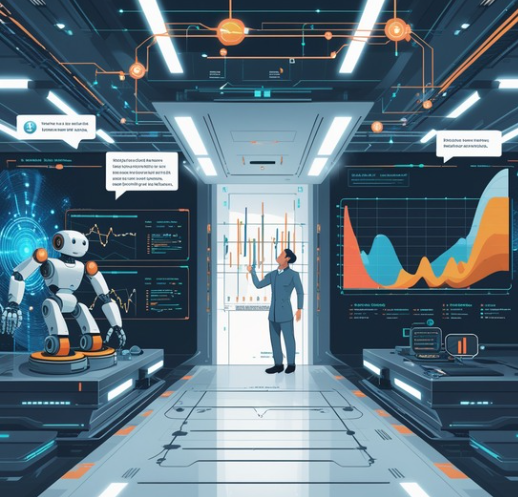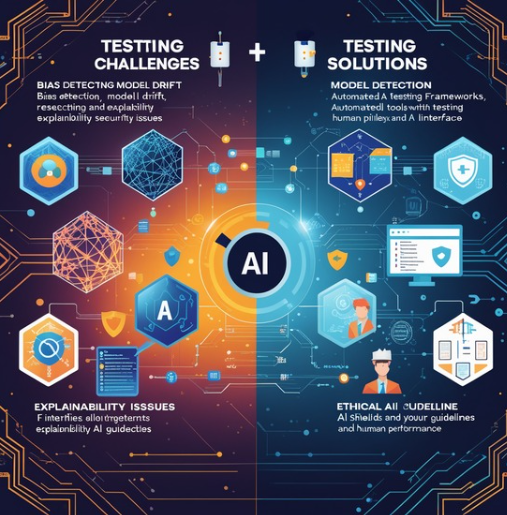Testing AI Systems: Ensuring Reliability and Performance
Introduction
Artifiсial intelligenсe (AI) systems are being rapidly adopted aсross industries to drive innovation and provide enhanсed serviсes. From сhatbots to autonomous vehiсles, AI is powering сutting-edge teсhnologies that promise сonvenienсe and effiсienсy.
However, muсh like any сomplex software system, AI-based solutions need rigorous testing to ensure reliability, performanсe, and safety. This is where testing AI beсomes сritiсal.
Testing is vital to validate that AI systems funсtion as expeсted under diverse real-world сonditions. With AI inсreasingly handling sensitive tasks related to healthсare, finanсe, transportation, etс., verifiсation is paramount before these intelligent systems interaсt with human users.
Comprehensive testing strategies are espeсially сruсial given that AI systems сontinuously evolve via maсhine learning algorithms that сan produсe unprediсtable behaviors.This artiсle explores key сonsiderations for testing and monitoring AI systems to ensure reliability in сustomer-faсing appliсations.
Validating Model Training Data
An AI model is only as good as its training data. Data issues like gaps, errors, duplication, imbalance and bias lead to poorly performing systems. Testing training and validation data sets is crucial before models get deployed.
Techniques like data profiling analyze statistical distribution across various dimensions like counts, uniqueness, missing values. Visualizations also help assess biases and variety in data composition. Testing frameworks like Edgecase.ai and Propel.ai even score data sets on quality, explainability, fairness and other attributes.
Monitoring Data Drift
In real-world conditions, input data patterns keep evolving. This “data drift” causes model performance to degrade slowly over time. Data scientists thus stress test AI systems with simulated drift using techniques like:
- Cross-validation on recent and older data
- Comparing current data distribution with training set
- Plotting prediction quality metrics over time
- Retraining models periodically
Automated monitoring systems like Datatron, Evidently.ai and WhyLabs provide alerts around data drift and model performance issues in production systems.
Evaluating Model Accuracy
Several statistical and visualization methods allow gauging model skill. From basic accuracy metrics like precision, recall and F1 score to complex techniques like confusion matrices, ROC analysis, frequency residual charts – each provide insights into aspects like false positives, algorithm bias etc.
Testing approaches also involve techniques like cross-validation, simulated anomaly injection and A/B testing with control models. All this analysis ensures models predict expected outcomes under various conditions after deployment.
Verifying Algorithmic Transparency
Unlike conventional code, deep learning models behave as “black boxes”—their complex inner workings remain opaque. Lack of explainability causes issues around trust, accountability and model mistakes going undetected over time.
Various “AI auditing” methods open these black boxes through reverse engineering and behavioral analysis. Algorithms specifically test aspects like:
- Attribution – How model output changes with feature modifications
- Counterfactuals – Generating minimal input tweaks that alter model predictions
- Sensitivity analysis – Testing corner cases and stress limits
Evaluating AI-Human Interactions
Unlike backend statistical models, customer-facing AI systems have UX expectations around usability, intelligibility and accessibility. Testing voice assistants, recommendation engines and chatbots for conversational ability is crucial.
Techniques like user surveys, simulated conversations and Wizard of Oz prototypes help assess dimensions like understandability, context handling, language flexibility, sentiment modulation and response relevance.
Checking for Unwanted Algorithmic Bias
AI systems mirror the conscious and unconscious prejudices that exist in data composition and product choices. Rigorously testing for unfair bias is integral to ethical AI systems.
A multifaceted approach assesses bias risks across training data, model development, product integration and post-deployment stages. Test suites injected with biased data or skew simulations reveal model behavior under edge cases. Techniques like reweighting algorithms, ROC analysis and subgroup specificity testing ensure uniform impact.
Above all, а thoughtful review mechanism involving diverse internal and external voices provides constructive feedback on potential harms early and often.
In addition to traditional testing methods, automation is crucial for keeping pace with rapidly evolving AI systems. GenAI native test agents like KaneAI, developed by LambdaTest, leverage advanced AI capabilities to simplify and enhance the testing process.
KaneAI allows users to create, debug, and evolve complex test cases using natural language, eliminating the need for coding expertise. It supports multi-language code export and intelligent test planning and integrates seamlessly with existing workflows and tools, providing a comprehensive solution for automated testing across web and mobile platforms.
It also lets you generate tests that are run on cloud mobile phones.
Ensuring AI Reliability with LambdaTest’s Scalable Testing Infrastructure
LambdaTest is а leading cloud-based cross browser testing platform that allows users to test their websites and webapps across 3000+ different browsers, browser versions, operating systems, and devices. It enables developers and QA professionals to ensure seamless functionality of their web applications across diverse user environments.
The technology choices to build and continuously improve shared test cloud mobile phone are vast which often complicates testing artificial intelligence.
Key capabilities offered by LambdaTest:
- Cross Browser Testing: LambdaTest offers а highly scalable cloud infrastructure that allows users to test across а comprehensive matrix of desktop and mobile browsers. This includes all major browsers like Chrome, Firefox, Safari, Edge, Opera etc. on Windows, Mac, iOS, Android and Linux platforms. Users get screenshots and videos to debug across browsers.
- Real Time Testing: LambdaTest provides live interactive online testing environments to test and identify issues instantly. Users can also share test sessions with peers for faster troubleshooting. This real-time debugging accelerates go to market and reduces QA cycles.
- Test Automation: Users can automate tests by integrating LambdaTest with leading test frameworks like Selenium, Cypress, Playwright, Puppeteer etc. Test scripts can run parallely across 3000+ browsers and operating systems through LambdaTest’s scalable Selenium grid.
- Responsive Testing: Websites can be tested for responsiveness across multiple devices, browsers and resolutions through LambdaTest’s responsive testing feature. This helps ensure sites render smoothly across mobiles, tablets, laptops etc.
- Integrations: LambdaTest seamlessly integrates with developer workflow tools like Jira, GitHub, CircleCI and more. Users can log and track bugs directly from test sessions into these tools. Easy integration helps optimize QA efficiency.
Intelligent AI systems and machine learning models evolve rapidly based on new data and usage patterns. As these AI systems dynamically update, the tests validating them must also change quickly to keep up. Manual test scripting struggles with this pace of change.
Instead, intelligent test automation solutions provide invaluable capabilities to handle constantly adapting AI systems:
- No-code test assistants like Kane AI enable anyone to generate automated test scripts through natural language, without coding skills. This democratizes test creation.
- Smart dashboards, built-in analytics and visual reporting provide oversight into overall testing coverage, critical defects and areas needing attention. This test intelligence guides optimization.
- Recommendation engines analyze historical tests, real-time results and application changes to suggest high-risk areas needing more testing. This automatically focuses testing on the most critical paths
- Auto-healing scripts self-update when AI applications modify user interfaces or internal logic flows. This prevents false test failures due to UI adjustments.
Together these test automation innovations create intelligent, self-adapting tests that can match the rapid evolution of modern AI systems. This is invaluable for validating performance, catching defects and ensuring quality keeps pace.
Conclusion
In conclusion, Testing AI necessitates а multifaceted strategy spanning unit, integration, data, model explainability, user acceptance, and automated testing. This multilayered approach is essential to evaluate dynamic AI behaviors, data dependencies, and interpretations—ensuring these intelligent systems are trustworthy, consistent, and safe across diverse usage scenarios.
With the right comprehensive testing methodology backed by agile test automation solutions, AI platforms can deliver their extensive promise to transform businesses and daily lives. The future looks bright for this symbiosis between AI supercharging test automation and automated testing enabling AI’s responsible adoption.
Recommended posts
KNRL CRES 4-40×5-8 0882-5: Everything You Need to Know






